Expanses of ornamentals planted principally for aesthetics in days past were to be found exclusively in the gardens of the wealthiest land baron or royal. There was little value for the average citizen in spending time and resources cultivating plants that didn't produce something useful. The yard was a plot for raising plants used for food, medicine, seasoning, scents and more.
We no longer rely on the yard solely for its production value, nor is a garden composed entirely of ornamentals beyond the reach of the average Joe or Jane. But doesn't a garden composed of plants both beautiful
and productive make sense? Say hello to the blended garden — or what I affectionately refer to as a cottage-potage garden — where fruits, herbs and veggies mix freely with ornamental species.
No need to lump the veggie garden in with the laundry line, garbage cans, compost bins and other drab service areas. Sure, a veggie garden can look a little punk in the off-season, but with a little imagination, it doesn't have to.
Beauty and BountyIt's time to stop banishing the edibles to the back 40 and bring them front and center. Feature them. Flaunt them. Celebrate them. Mix edibles into your borders; plant veggies and herbs in beautiful containers scattered throughout your outdoor spaces, add fruit trees along the curb strip. Need a shade tree? Pick one that provides fruit as well. Need to screen something out of your view? Try a fast-growing evergreen fruiting vine.
By integrating edibles and ornamentals we get beauty
and bounty — while squeezing the most out of the time and resources we spend in our modern-day yard. You're just a few strawberry plants, some lettuce seeds and maybe a fruit tree or two away from your own beautiful and highly productive cottage-potage garden.
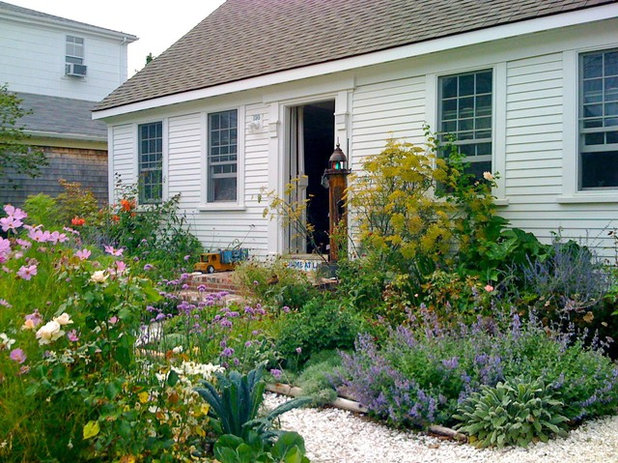 The cottage-potage garden.
The cottage-potage garden. I imagine the historic predecessor of what I call the cottage-potage garden might have looked a bit like this garden, with edibles such as kale (in the foreground), herbs and squash (adjacent to the house) planted here and there alongside scented flowers and ornamentals.
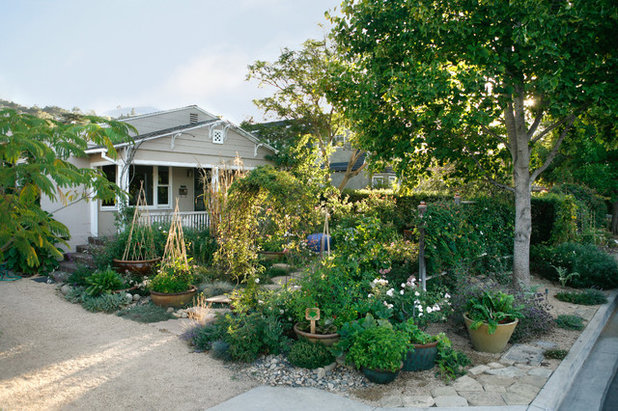
Margie Grace - Grace Design Associates
My own blended garden. My own garden has seen a lot of change over the 20-plus years I've been tending it. I began raising produce in large, colorful containers set among flowering perennials in the curb strip and along the driveway about eight years ago. The large pots provide plenty of no-bend, clean-shoe gardening (my favorite kind). The pots are placed where there's great sun exposure and air circulation, providing structure, color and interest to the garden. They look great at the height of the growing season and in the off-season as well.
I come home at the end of the day and spend about five minutes between the curb and my front door. By the time I cross the threshold with a handful of fresh fare, I've figured out what's for dinner
and decompressed from the stresses of the day.
Tip: To hold down costs, I selected pots from the heavily discounted "seconds, chips and dings" section at large pottery supply stores.
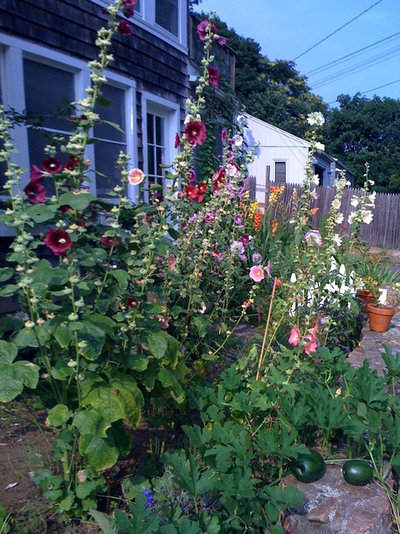 A space-saving, high-density producer.
A space-saving, high-density producer. Watermelon is tucked below the towering hollyhocks to squeeze the most out of the space in this free-spirited garden.
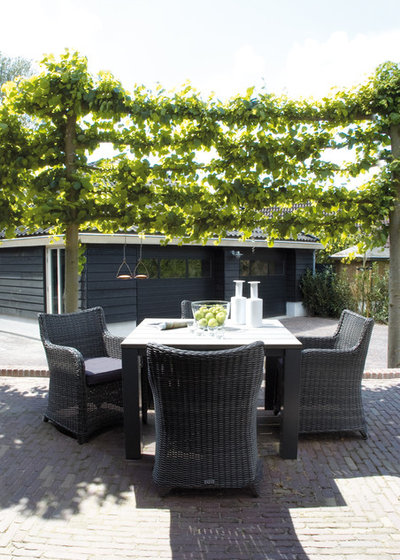
HUISSTYLING
Small space? Espalier and graft. Apple, pear, fig and other fruit trees are easily espaliered (trained to grow flat against a wall, a trellis or an arrangement of stakes). This espalier provides screening
and fresh fruit.
Tip: Want more kinds of fruit than you've got space for trees? Select "fruit salad" trees with multiple varieties grafted onto a single espaliered plant.
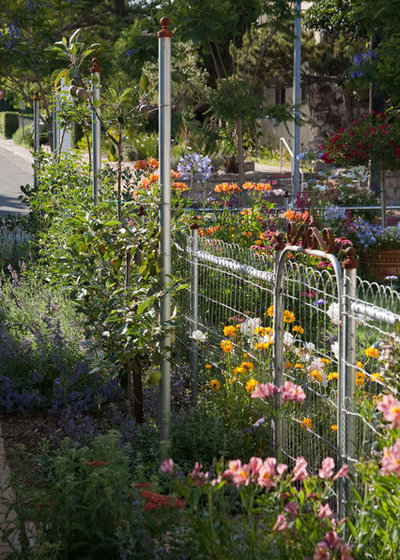
Margie Grace - Grace Design Associates
Ditch the orchard. Newly planted espaliered apple trees are at home in this perennial border, providing bushels of apples to go with an abundance of fresh bouquets. These trees have been trained as cordons,
the familiar form of grape vines. Growth is limited to a few principal horizontal branches within easy reach.
The cordoned apples provide needed screening for this front-yard garden, and the nearby flowers attract pollinators, which enhance fruit production.
Tip: Annual dormant-season pruning increases the number and density of fruit buds, reducing the overall footprint of the tree while maintaining high yields.
This garden is located on a quarter-acre four-unit multifamily residential site in downtown Santa Barbara, California. Vegetables, herbs, ornamentals and more than 30 fruit trees joyfully, beautifully and fruitfully coexist, thriving on harvested rainwater. Talk about getting the most out of your resources!
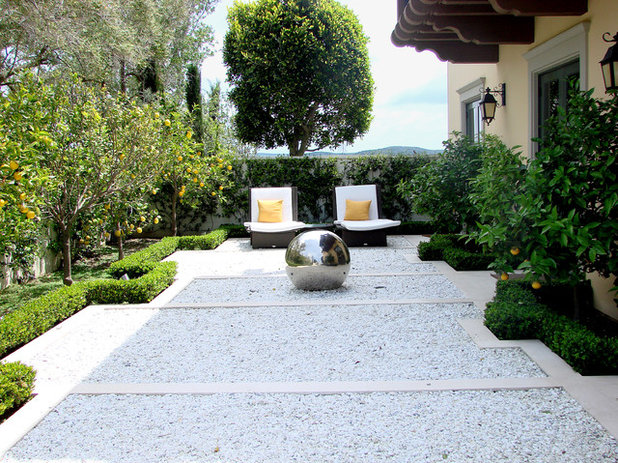
AMS Landscape Design Studios, Inc.
The modern edible. The blended garden readily adapts to any garden style. Fruit trees are seamlessly incorporated into this modern outdoor sitting area, elevating the space from merely beautiful to bountiful as well.
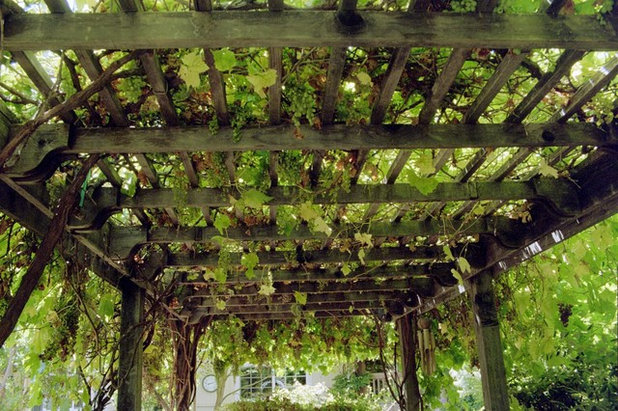
Diane Licht Landscape Architect
Double-duty design. A vine-laden arbor provides shade for an outdoor dining room and heaps of fresh table grapes. These vigorous vines aren't too fussy about soil, can withstand periods of drought once established and, other than annual pruning and a little tying up, require little maintenance. Consider planting several varieties of grape on a large arbor for a cornucopia of fresh fruit.
Vines are not the only fruit that can be trained to grow overhead. Although slower than vines, lemon, lime, fig, apple and pear — to name just a few — are great choices to cover an arbor or a pergola.
Tip: Use a deciduous vine such as grape or kiwifruit where you want to have shade in the summer and sun in the winter.
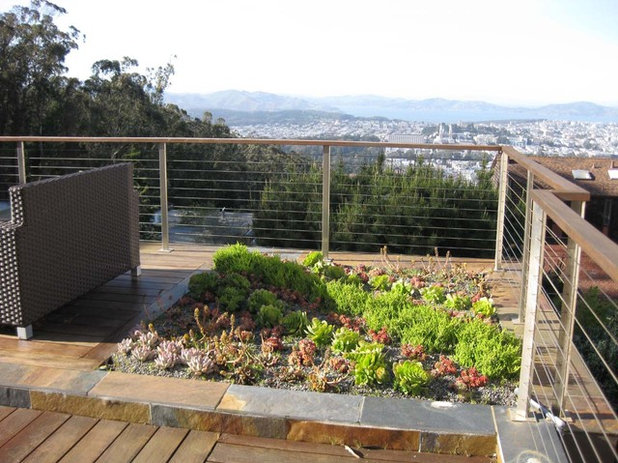
Mark English Architects, AIA
Variety is the spice of life. Look for interesting color and form in the wide variety of veggies, herbs and fruits available. A wealth of beautiful forms and colors exist to add interest to perennial beds and containers.
Or try a twist on the veggie garden that you'll be thrilled to feature front and center. In this photo, colorful row crops are laid out on a jaunty angle, adding play and movement to the composition.
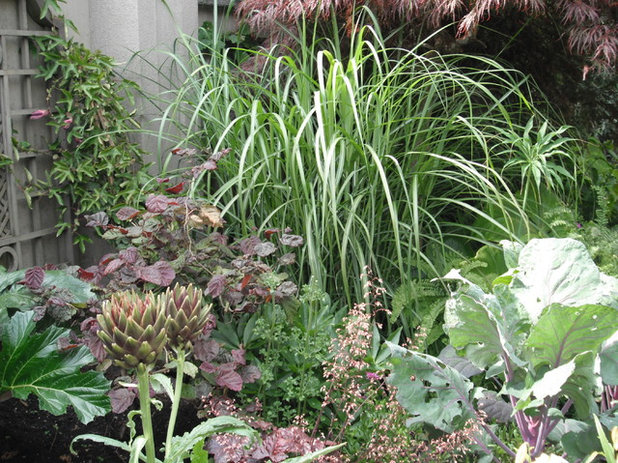
Glenna Partridge Garden Design
Exploit the ornamental qualities of food-bearing plants. Artichokes, for instance, are strikingly beautiful incorporated into a planting scheme. They provide color, texture and structural interest — as well as a delicious feast. Eat them when they're young and tasty for the freshest 'choke you've ever had, and leave a few to develop into huge, dramatic purple-blue blooms to cut and bring indoors.
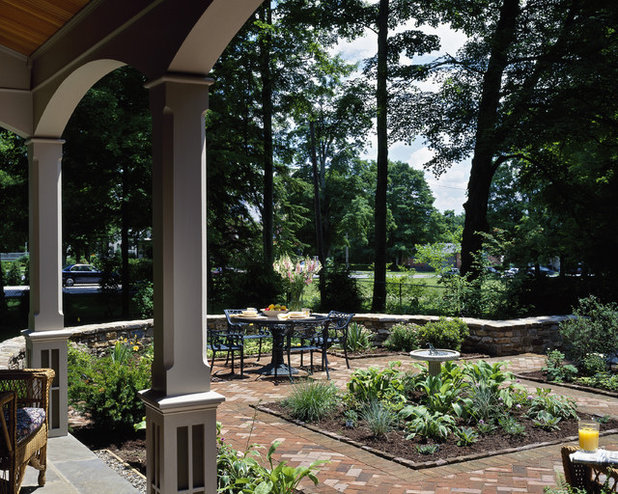
Witt Construction
Still prefer a traditional veggie patch? No problem — keep the veggies together but give some thought to the layout and construction of beds. Break out of the standard 4 feet by 8 feet raised wood beds lined up along the back property line.
Give your beds style and an attractive layout that looks great year-round. Include a space for lounging, dining or entertaining. Low stone walls add structure, enclosure, visual interest and additional seating in this combined veggie garden and dining patio.
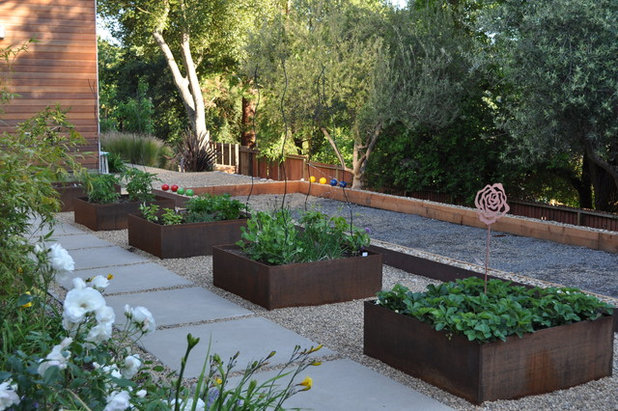
Huettl Landscape Architecture
Veggies plus play. Raised Cor-Ten beds are superstylish and play well with the steel-edged boccie court. Look for opportunities to integrate your veggie patch with other outdoor spaces to get the most use, value and joy from your garden.
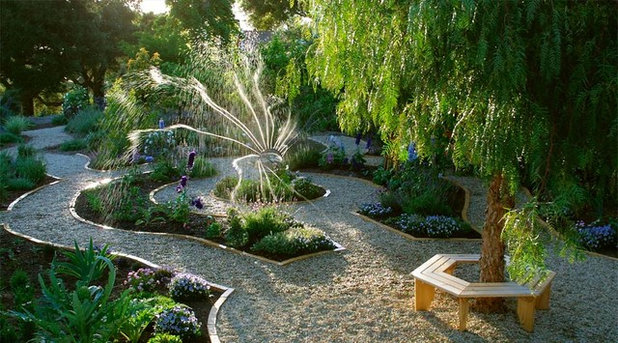
Margie Grace - Grace Design Associates
Strong structure for strong interest. This parterre-inspired veggie garden, with its strong architectural lines, is attractive year-round. Add the playful sprinkler — which looks like an armillary sphere when not in operation — and you have a vegetable garden that's fetching enough for center stage.
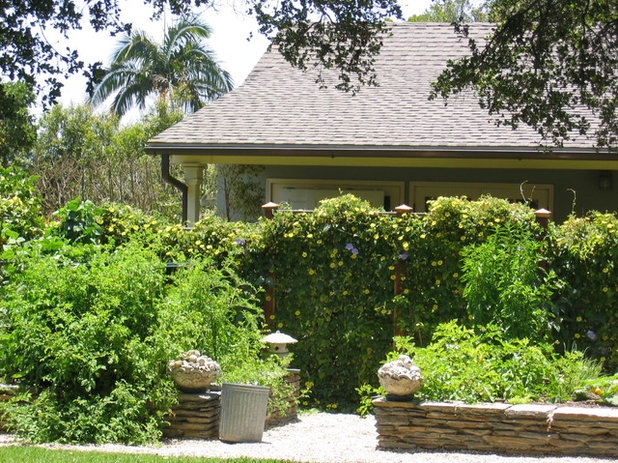 Make raised beds a focal point.
Make raised beds a focal point. Rather than hide the veg patch from view, these homeowners chose to cultivate their produce in beautiful raised stone beds, which also serve as a focal point at the end of their backyard. The stone walls provide extra seating for large gatherings and bring crops within easy reach without the need for bending or stooping.
More:Experiments Aplenty Fill Vancouver Edible Garden





